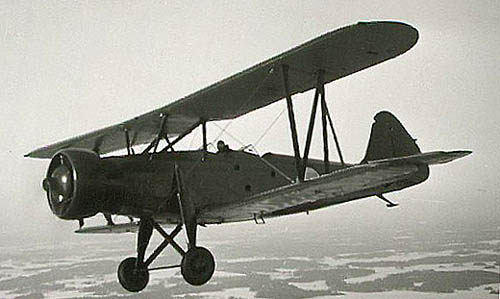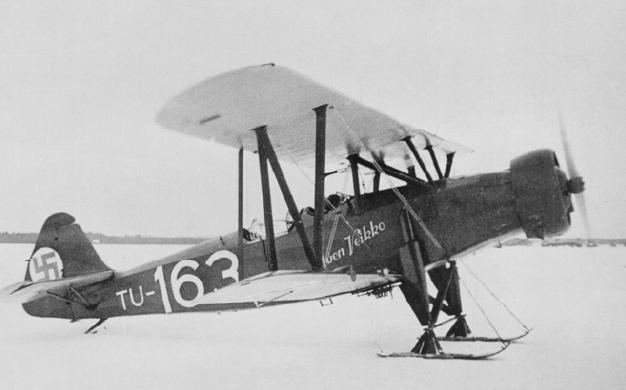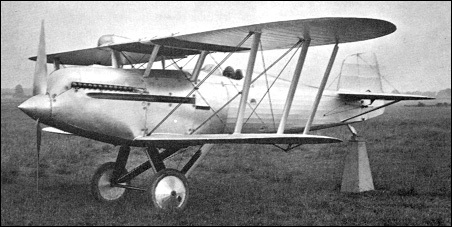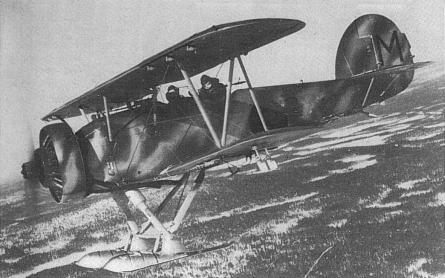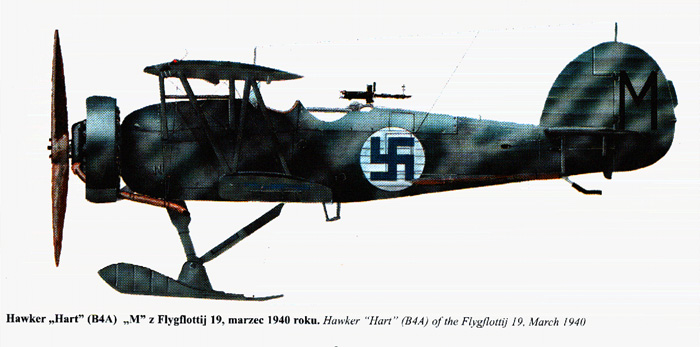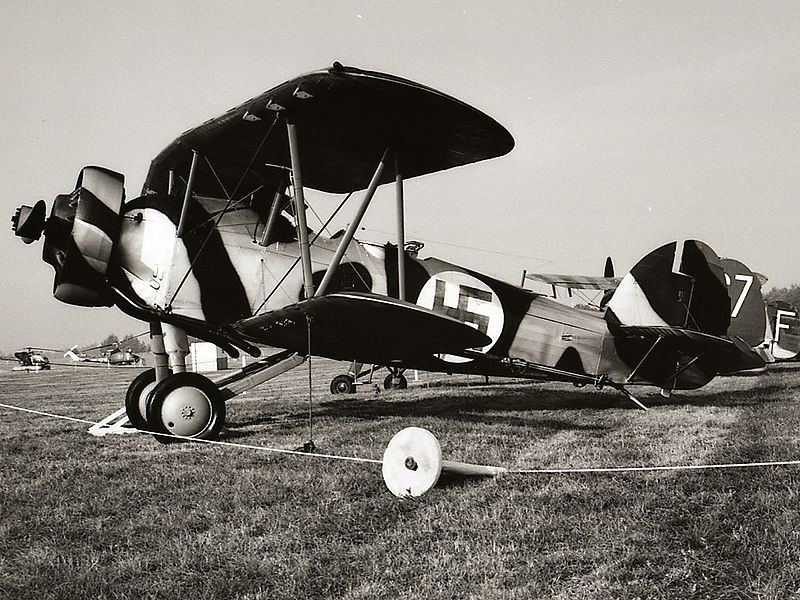Again in 1933, the Ilmavoimat procurement program emphasised the purchase of trainers and fighters. A high priority had been given to the continual acquisition of modern fighter aircraft – and with no attempts to compromise by ordering aircraft with multiple capabilities. Even in the early 1930’s, it was envisaged that any war with the Soviet Union would involve the Red Air Force attacking Douhet-style with waves of unescorted bombers and the counter would thus be Fighter aircraft. Conversely, Finland’s small population and economy could never support the number of bomber aircraft necessary for a Douhet-style bombing campaign against any enemy, let alone the Soviet Union – strategic bombing was therefore eschewed from the start and where the Ilmavoimat selected bomber aircraft, the primary emphasis was to be on support for the Maavoimat and Merivoimat – and with a marked emphasis on the capability to carry out accurate ground attack bombing.
Trials carried out had long concluded that high altitude bombing from level flight was wildly inaccurate and the Ilmavoimat would never have enough aircraft to carry out effective area-saturation bombing as Douhet and his disciples advocated. On the other hand, in the evaluation trials with the Curtiss Helldivers, the Ilmavoimat had established that it was possible to accurately aim for and hit small targets. Accurate low-level bombing was also achievable with training and practice, but again this was more suitable for attacking specific targets rather than saturation bombing – and also could be carried out with small numbers of aircraft. Provision had been made for the purchase of bomber-types in the five year plan and it was decided that the 1933 procurement program would include a capable medium bomber, which would then be extensively tested in combined arms and tactical bombing exercises and evaluated for effectiveness.
As a result, in 1933 and with the Curtiss Helldivers already ordered, the Ilmavoimat opted to purchase a limited number of medium bombers, additional fighters and the new Finnish-design Tuiska Advance Trainer.
Ilmavoimat VL Tuiska Advanced Trainers – 40 ordered in late 1933 (an additional 40 were ordered in 1935)
The VL Tuisku (Snowstorm) was a Finnish-design two-seat mixed structure (welded steel framework covered with fabric) biplane with a fixed undercarriage designed as an advanced trainer aircraft with fixed undercarriage. The Designer was Arvo Ylinen (who was in 1933 the chief designer at Valtion Lentokonetehdas). As an Advanced Fighter Trainer, the first prototype was ordered from VL in January 1933. The first test flights for this aircraft were performed over spring 1933 by Lieutenant U.E. Mäkelä. The prototype broke up in the early test flights due to flutter developing – Lieutenant Mäkelä parachuted to safety. The problem was identified and eliminated for the second prototype, which was ready in early summer 1933. The test flight program was completed by 5 September, 1933. Overall, the aircraft’s flying characteristics were considered to be excellent.
Immediately after the completion of the test flight program, an order was placed with VL for 40 aircraft. Construction began immediately with delivery taking place over summer 1934 and into early 1935. As an advanced trainer, the VL Tuiska proved to be a success. A second production series for an additional 40 aircraft was ordered on 14 Feb, 1935. These aircraft were delivered over mid 1935 to mid 1936. Three different versions of the aircraft were constructed: a maritime training, a pilot training and a reconnaissance training version, with the numbers being approximately equally distributed between the types. The Tuiska remained in use as an Advanced Trainer until 1950. The Tuiska was fitted with 2×7.62mm machineguns and could carry 4 x12.5 to 23kg bombs.
As well as being used for Training, the aircraft could be used for Reconnaissance. With a crew of 2 (Instructor and Trainee) the Tuisku was powered by a single aircooled Armstrong Siddeley Lynx IVC 7-cylinder radial, 160 kW (215 hp) giving a maximum speed of 129mph, a range of 715 miles and had a service ceiling of 14,436 feet. The aircraft proved a reliable and cost-effective platform in a wide variety of roles, and the Tuisku (“Snowstorm”) can be regarded as one of the most successful aircraft types designed in Finland. It made a significant contribution to the development of the Ilmavoimat in the 1930s.
OTL Note: OTL, the first prototype was ordered from the State Aircraft Factory in the spring of 1933. The first flight for this aircraft was performed on 10 Jan, 1934. The second prototype was ready in the beginning of 1935 and the test flight program was finished by 5 Feb, 1935. 12 aircraft were ordered in the same month. They were delivered in the summer of 1936. One additional Tuisku was donated to the Air Force on 19 Apr, 1936. A second production series was ordered on 14 Feb, 1936. These 16 aircraft were delivered in 1937. Again one additional aircraft was donated to the Air Force. One Tuisku, named “Sokeri-Sirkku” (TU-178) is preserved and on display at the air museum in Vantaa. The fuselage of TU-169 is preserved in the museum’s storage facilities. A Tuisku is also on display in front of the old State Aircraft Factory in Tampere.
Ilmavoimat Fairey Firefly II Biplane Fighter – 25 ordered early 1933, retired 1940
The earlier purchase of the Bristol Bulldog Fighter had proved to be a success, and this influenced the decision to but a further and more modern Fighter aircraft from Britain. The Ilmavoimat and VL evaluated both the new British Fighters that had been developed in response the the UK Air Ministry Specification F.20/27 for a single-seat interceptor. The Fiat CR.30 was also evaluated but was not as fast, although it had double the range. The Firefly II competed for the RAF contract against the Hawker Fury, showing superior speed but was criticised for having heavier controls. Crucially, it retained a mainly wooden structure despite the UK Air Ministry’s demands for metal structures. In the UK, this led to the Fury being selected. VL however preferred the wooden structure – this was technology they were used to working with and while they were working to build up experience with the new metal structural technology, this was as yet not a strong point. The Firefly was also somewhat cheaper and, crucially, faster. The Procurement Team therefore opted for the purchase of the Firefly II. In hindsight, this was probably not an “ideal” choice, but the Firefly did prove to be an adequate fighter, if outdated by the time of the Winter War.
The Finnish order for 25 Firefly II’s was placed at the end of the first quarter of 1933, with Fairey’s UK factory building the aircraft. They were delivered to Finland six months later, assembled and tested over the winter and entered service with the Ilmavoimat in March 1934. As with the Bristol Bulldog, with Firefly II was utilised as a fighter in the Winter War, with limited success. It was relegated to use as an Advanced Fighter Trainer in early 1940 as new Fighters became available and entered service.
The Fairey Firefly II was a good high-speed interceptor Fighter in its day, albeit with limited range. With a maximum speed of 223mph at 13,000 feet, it had a range of 240 miles and a service ceiling of 30,840 feet. A single seater, it was armed with 2 × 0.303 in (7.7 mm) Vickers machine guns.
OTL Note: The Firefly was a private-venture design, penned by Marcel Lobelle. A contract was won for 25 IIM aircraft for Belgium’s Aéronautique Militaire, followed by a contract for a further 62 to be constructed by Avions Fairey, Fairey’s Belgian subsidiary. The Belgian aircraft served briefly in the Second World War from May to June 1940. Two of the Belgian aircraft were converted to Firefly IV, with 785 hp (585 kW) Hispano-Suiza 12Xbrs engines but the improvement was not deemed sufficient to warrant development. One was restored to its original form, while the other passed to Fairey for trials. One aircraft was supplied to the Soviet Union.
Ilmavoimat Hawker Hart Light Bomber – 20 ordered mid-1933, retired 1943
After an assessment of light and medium bombers available, the Procurement Team settled in early 1933 on the British Hawker Hart Light Bomber. An evaluation aircraft was ordered and after delivery in April, an extensive evaluation program was flown over May and June 1933. The results were such that an immediate order was placed for 20 of the aircraft, with delivery confirmed for late 1933. The Hart’s delivery was delayed due to the large number of orders that had been received for the aircraft, with delivery actually taking place in early 1934.
Ilmavoimat Hawker Hart
The Hawker Hart was a British two-seater biplane light bomber of the Royal Air Force (RAF), which had a prominent role during the RAF’s inter-war period. The Hart was designed during the 1920s by Sydney Camm in response to a 1926 UK Air Ministry requirement for for a two-seat high-performance light day-bomber, to be of all-metal construction and with a maximum speed of 160 mph (258 km/h). Designs were tendered by Hawker, Avro and de Havilland. Fairey, who had sold a squadron’s worth of its wooden Fox bomber in 1925, was not at first invited to tender to the specification, and was only sent a copy of the specification after protesting to the Chief of the Air Staff, Hugh Trenchard.
Hawker’s design was a single-bay biplane powered by a Rolls-Royce F.XI water-cooled V12 engine (the engine that later became known as the Rolls-Royce Kestrel). It had, as the specification required, a metal structure, with a fuselage structure of steel-tube covered by aluminium panels and fabric, with the wings having steel spars and duralumin ribs, covered in fabric. The crew of two sat in individual tandem cockpits, with the pilot sitting under the wing trailing edge, and operating a single .303 in (7.7 mm) Vickers machine gun mounted on the port side of the cockpit. The observer sat behind the pilot, and was armed with a single Lewis gun on a ring mount, while for bomb-aiming, he lay prone under the pilots seat. Up to 520 pounds (240 kg) of bombs could be carried under the aircraft’s wings.
The prototype Hart first flew in June 1928 and demonstrated good performance and handling, reaching 176 mph (283 km/h) in level flight and 282 mph (454 km/h) in a vertical dive. The competition culminated in the choice of the Hawker Hart by the UK Air Ministry in April 1929. Of its competitors, the de Havilland Hound was rejected due to handling problems during landing and because of its part-wooden primary structure. While the Avro Antelope demonstrated similar performance and good handling, the Hart was preferred as it was far cheaper to maintain, a vital aspect to a programme during defence budget constraints that the British armed forces faced during the 1920s. The Fairey Fox IIM (which despite the name was effectively an all-new aircraft), delayed by Fairey’s late start on the design compared to the other competitors, only flew for the first time on 25 October 1929, long after the Hart had been selected.
The production Hart day bomber had a single 525 hp (390 kW) Rolls-Royce Kestrel IB 12-cylinder V-type engine; a speed of 184 mph (296 km/h) and a range of 470 mi (757 km). It was faster than most contemporary fighters, an astonishing achievement considering it was a light bomber, and had high manoeuvrability, making the Hart one of the most effective biplane bombers ever produced for the Royal Air Force. In particular, it was faster than the Bristol Bulldog, which had recently entered service as the RAF’s front line fighter. This disparity in performance led the RAF to gradually replace the Bulldog with the Hawker Fury. A total of 992 aircraft were built as Harts. It became the most widely used light bomber of its time and the design would prove to be a successful one with a number of derivatives, including the Hawker Hind and Hector, being made. In addition, a specialised Hart Trainer was also designed. Vickers built 114 of the latter model at Weybridge between 1931 and June 1936. Demand for the bomber was such that 164 were built by Vickers-Armstrongs at its Weybridge factory at Brooklands between 1931 and 1936 after that company’s submission of a tender, alongside the trainers mentioned above.
Thus, in selecting the Hawker Hart in 1933, the Ilmavoimat was buying an aircraft that was already tested and proven as effective in its role. The Ilmavoimat pilots took to the Hart immediately. It proved to be a superb performer, highly effective in its role and capable of being used well outside the parameters envisaged by the designers. With the example of the Curtiss Helldivers, the Ilmavoimat Pilots quickly developed dive-bombing techniques for the aircraft. When the Hawker engineers found out, they issued a formal objection, stating that the aircraft had not been designed for that purpose; however, Ilmavoimat pilots proved that the aircraft was up to the task and dispelled their concerns (or at least, ignored them). Swedish Air Force General Bjorn Bjuggren wrote in his memoirs about how his squadron developed dive-bombing techniques in the mid-1930s for their B4 Harts – there is probably some Swedish bias here, as it was well known at the time within the Ilmavoimat that the Swedes had observed the Ilmavoimat pilots carrying out dive-bombing exercises with their Harts and had copied the technique from them.
RAF Hawker Harts, No 12 Squadron, Andover Aerodrome 1931 – Ilmavoimat Hawker Hart’s in 1933 would have looked a lot like this
Neighboring Sweden had also purchased the Hawker Harts – in 1934, the Swedish Air Force purchased four Hawker-built pattern aircraft, powered by a Bristol Pegasus IM2 radial piston engine – these were delivered in 1934. Following successful evaluation, 42 were built under licence in Sweden, powered by a Swedish-built NOHAB Pegasus IU2. A number of these Swedish Harts fought in the Winter War as part of the Swedish F19 volunteer unit assisting the Finns. The Ilmavoimat found that the performance of the Hart was such that it could outfly their older fighters and it also proved to be a highlly maneuverable aircraft – consequently, the Ilmavoimat added a second Vickers machine gun, while the coaming of the rear cockpit was angled to give a better field of fire for the observer. The Hart’s fought with the Ilmavoimat through the duration of the Winter War and remained in service until 1943, when they were retired as a flood of American Lend-Lease Aircraft (and some Russian aircraft) began entering service with the Ilmavoimat prior to Finland’s entry into WW2 against Germany.
- And lastly – a Swedish Hawker Hart in Ilmavoimat markings – photo taken in 1976
Next: The Ilmavoimat 1934 Procurement Program
 Copyright secured by Digiprove © 2013 Alternative Finland
Copyright secured by Digiprove © 2013 Alternative Finland


